Everything you need to know about the Philodendron Gloriosum
Philodendron Gloriosum is a slow grower and benefits from regular feeding. A liquid fertilizer at half-strength once per month during the growing season is perfect. Then every 8 weeks to 3 months in the autumn and winter.
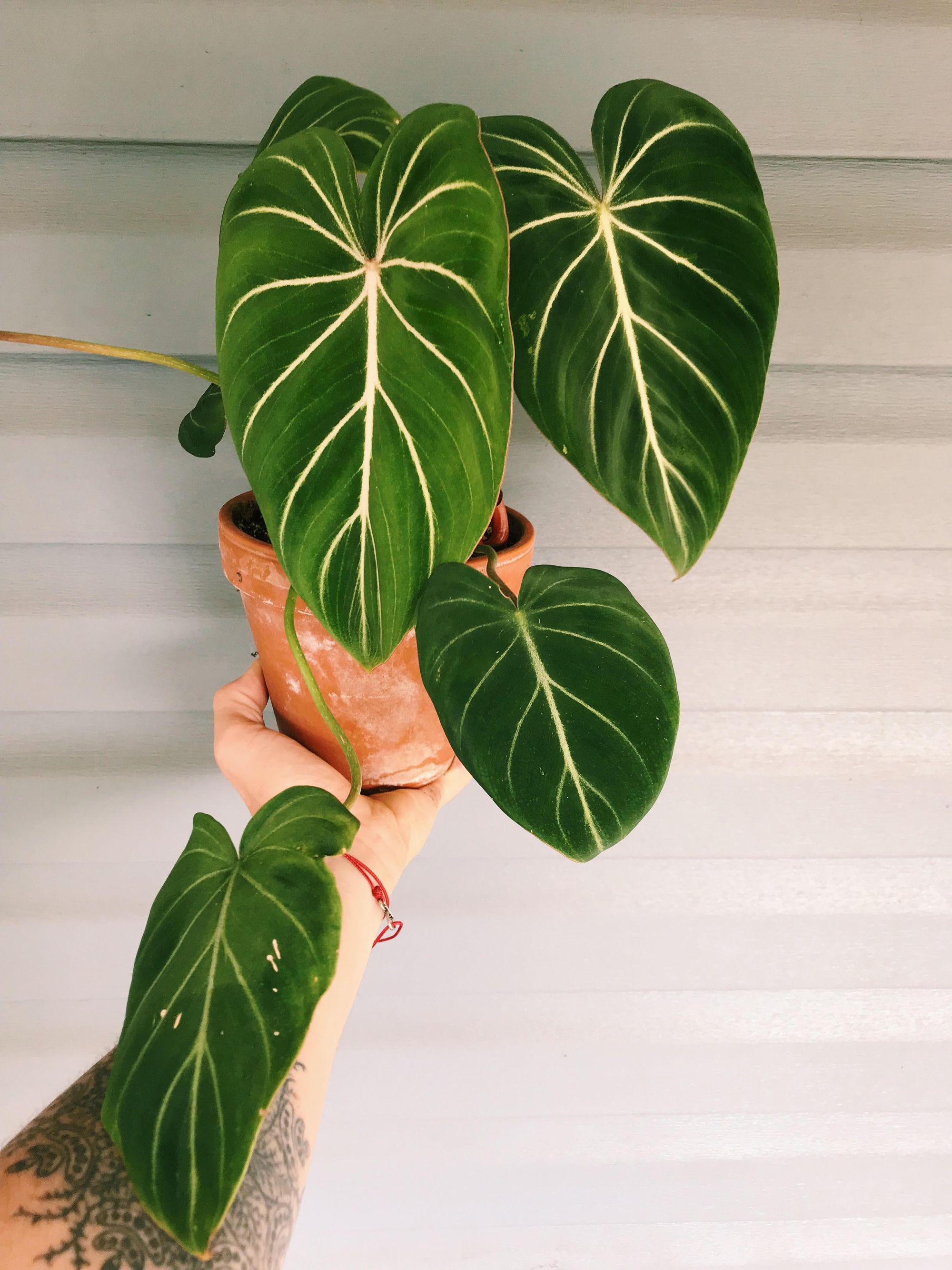
The name says it all—meet the glorious green newcomer to the popular house plant scene, Philodendron Gloriosum.
The Gloriosum has velvety green leaves with stunning white veins and charming heart-shaped leaves, making it rare amongst its kind. The “Velvet Philodendron”, as it’s also known, is prized as a house plant for its air-purifying properties.
Read on for tips on caring for your Philodendron Gloriosum.
What are the most important things to look out for in Philodendron Gloriosum?
Gloriosum is a rarity among its kind, so here are the care highlights if you can’t wait to start adding them to your collection:
- Soil - Drainage is critical as root rot is common. Well-draining, neutral pH soil is critical
- Watering - You need to get the balance just right. Consistently moist, never soggy
- Rhizome - That odd-looking thing at the base. Keep it uncovered or face root rot
- Growth - Slow growers like these require patience. Don’t be discouraged
- Humidity - Higher, the better. Gloriosum is forgiving...up to a point. Aim for 70-80%.
- Pests/Diseases - Spider mites and root rot are the ones to watch for
- Temperature - Hates fluctuations. Aim to keep it between 65 and 85°F
- Toxic - Very poisonous to you, your cat and your dog. Cramps, swelling, irritation, even kidney failure
Are Philodendron Gloriosum hard to care for?
Despite their rarity, Philodendron Gloriosum is one of a select group of tropical plants that won’t cause first-timers to pull their hair out in frustration.
Temperature and watering are the most challenging parts of gloriosum care, as with most tropical plants. Once you have your care routine nailed, however, it becomes a breeze.
All things considered, they’re not a very fussy plant. Keep them out of direct sunlight. Prioritise good drainage when watering. Keep them consistently warm enough. Grab a beverage and sit back and enjoy their majesty.
Philodendron Dark Form vs Regular Form
Not many people know this but there is another variety of the Philodendron Gloriosum. This darker coloured variety is known as the "Dark Form" Philodendron Gloriosum.
The difference between the "dark form" of this philodendron and its lighter colored counterpart is subtle but notable. The leaves are a darker green color, which makes the white veined lines "pop" out more.
Here is a picture of a Dark form Philodendron:

What Temperatures does the Philodendron Gloriosum need?
Unless you live in a fridge or in a giant George Foreman grill, Philodendron Gloriosum will flourish in most typical household temperatures.
Temperatures between 65 and 85°F are perfect, so if you’re working on an indoor jungle to show off your plants, it’s ideal. A greenhouse is even better. We’ve seen some brilliant indoor greenhouse adaptations recently—like temperature-regulated display cases. They’re a nice touch and suit your tropical lovelies down to the ground.
Here is an example of an Indoor Greenhouse below:
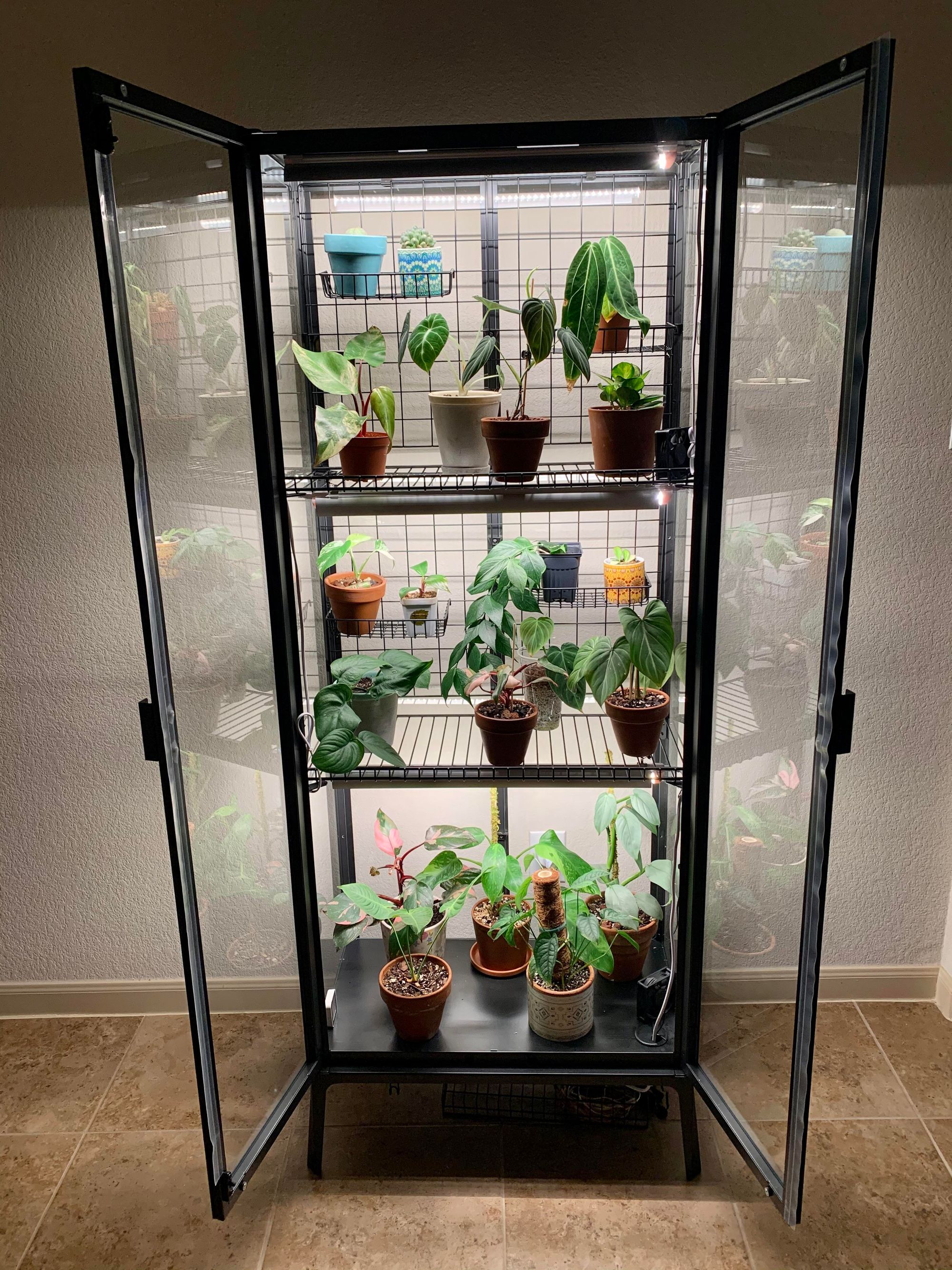
Keep an eye on the thermometer if you like keeping your tropical plants outdoors. If temperatures fall below 60°F, severe harm will befall your gloriosum. So try to avoid placing your plant near breezy open windows, air conditioning units or radiators.
What Humidity levels does a Gloriosum plant need?
If large, vibrant, velvety leaves are what you’re after (and who isn’t?), then higher humidity will see your gloriosum thrive. Percentages around 70-80% are perfect.
Anything below 40% humidity, and you’re in the danger zone. Low humidity will result in growth issues for this already slow-growing plant, poor-quality foliage, and brown tips.
How to Boost Humidity for your Philodendron Gloriosum
- Sand, pebbles, shells. Chuck some of these around the base of your plant to capture moisture when you water.
- Group some of your tropical plants together to create a blissfully humid microclimate for them to share and thrive in.
- Regularly misting your plants may help but will only be effective if combined with the above bullets.
How should you Water Philodendron Gloriosum?
“Moist, but never soggy.” Words to live by, especially when watering your Philodendron Gloriosum. As a tropical native, your gloriosum will thank you for keeping its soil perpetually damp like the jungles of home by rewarding you with lush, vibrant leaves year-round.
Despite its love for moisture, you can still overwater your Gloriosum. You might want to adopt a “little and often” mentality when it comes to watering. What does that look like? Let the topsoil dry a little before every watering, but never let the whole soil bed become dry.
You can test for this by poking your finger or a chopstick into the soil a few inches. If it’s still damp all the way through, you can hold off on watering for now. But if the top couple of inches are dry, give that little beauty a drink.
Overwatering will cause root rot, which is especially dangerous for the rhizome of this plant. Make sure the rhizome stays uncovered and that the soil has excellent drainage.
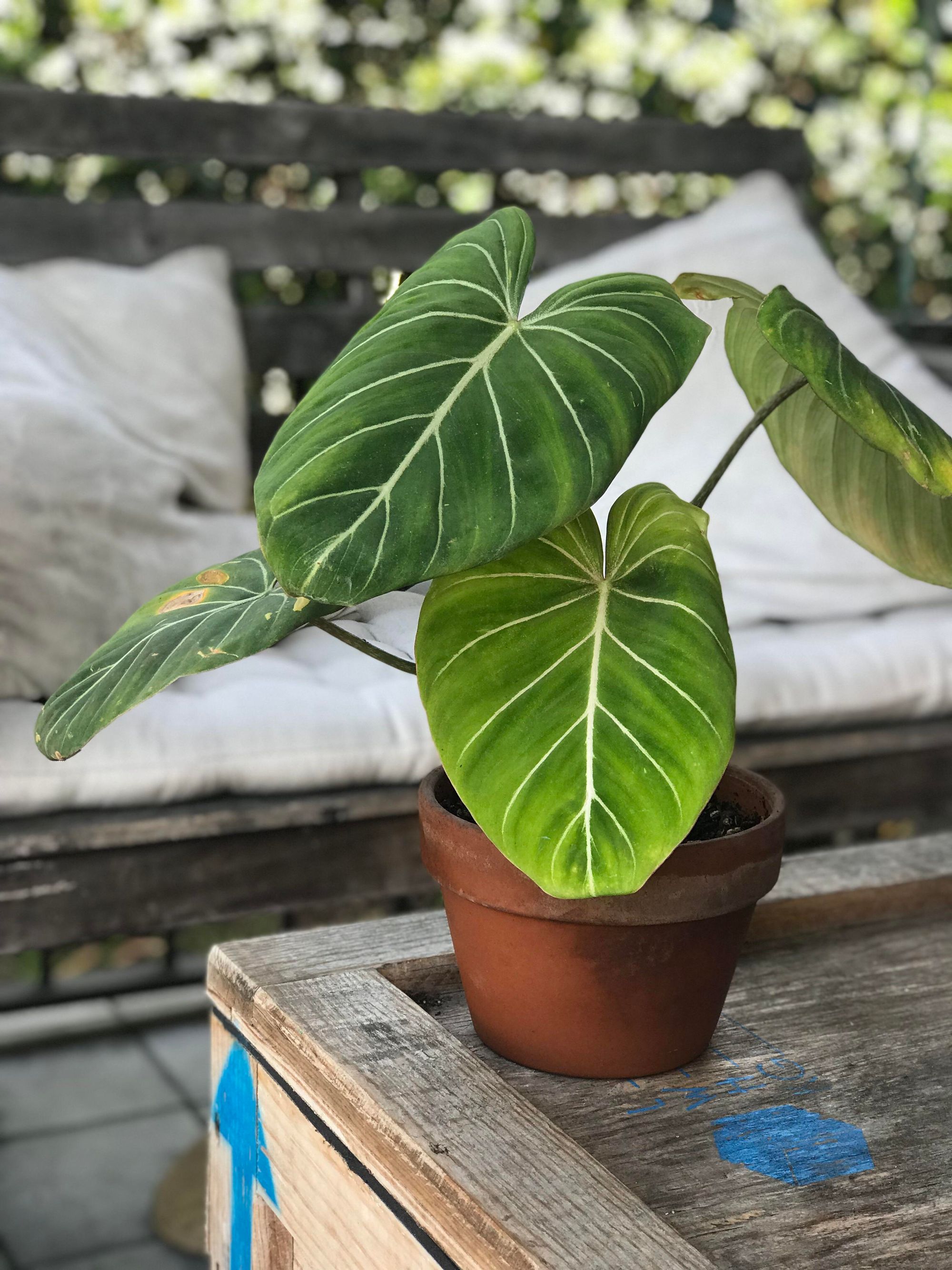
What Should You Feed Philodendron Gloriosum?
Philodendron Gloriosum is a slow grower and benefits from regular feeding. A liquid fertilizer at half-strength once per month during the growing season is perfect. Then every 8 weeks to 3 months in the autumn and winter. We recommend a liquid fertilizer for easy dilution and because they tend to be milder than alternatives.
Contrary to what you might assume, overfeeding will slow growth to almost nothing and comes with many issues. Chief among them is root burn. It sounds like a cool reggae band but is actually very harmful to your plant.
It’s good practice to flush the soil and roots of your gloriosum every three months to reduce the build-up of mineral salts that will occur from fertilizer use. Those salts are the cause of root burn.
How fast does Philodendron Gloriosum grow?
Agonizingly slowly. From leaf spike to full opening can take between one and two months. Tactical and careful use of fertilizers can speed up this growth and encourage more leaf spikes to form.
When they are fully grown, gloriosum can reach sizes of around 90cm, which is nothing to balk at.
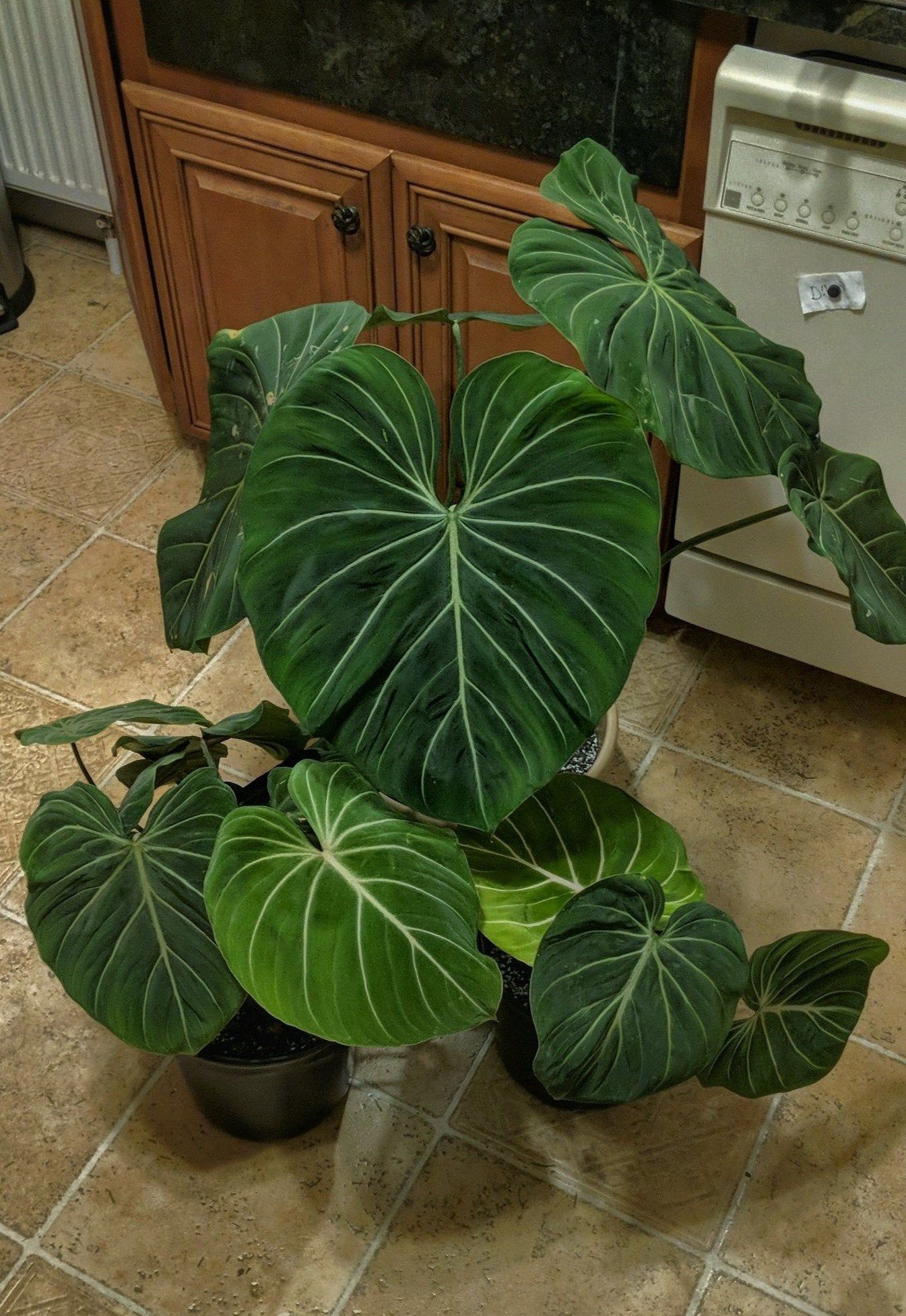
What Diseases and Pests do Philodendron Gloriosum suffer from?
Blissfully, Philodendron Gloriosum isn’t particularly prone to pests. But that doesn’t mean it can’t suffer from them.
Aphids, mealybugs, spider mites and fungus gnats can still plague these beauties if other plants in your collection carry them. Fortunately, gloriosum is pretty hardy and won’t suffer too severely.
Their robust constitution means they’re only particularly prone to one significant disease, which is a killer among many tropical plants—root rot.
Fear not, however. Philodendron Gloriosum is exceptional at coping with pest treatments, despite their dainty and delicate appearance. Go natural, not chemical, and your gloriosum will continue to flourish as it fights off the pests.
In some cases Pseudomonas cichorii (a type of Bacteria) can infect your phildendron leaves. Sadly, there's no treatment for bacterial leaf spot aside from keeping the leaves and plant as dry as possible. You can try using a fungicide or neem oil to prevent the disease from spreading. Make sure you separate this particular plant from your other plants, bacterial diseases are no joke, they're transferable by leaves touching and stray drops of water.
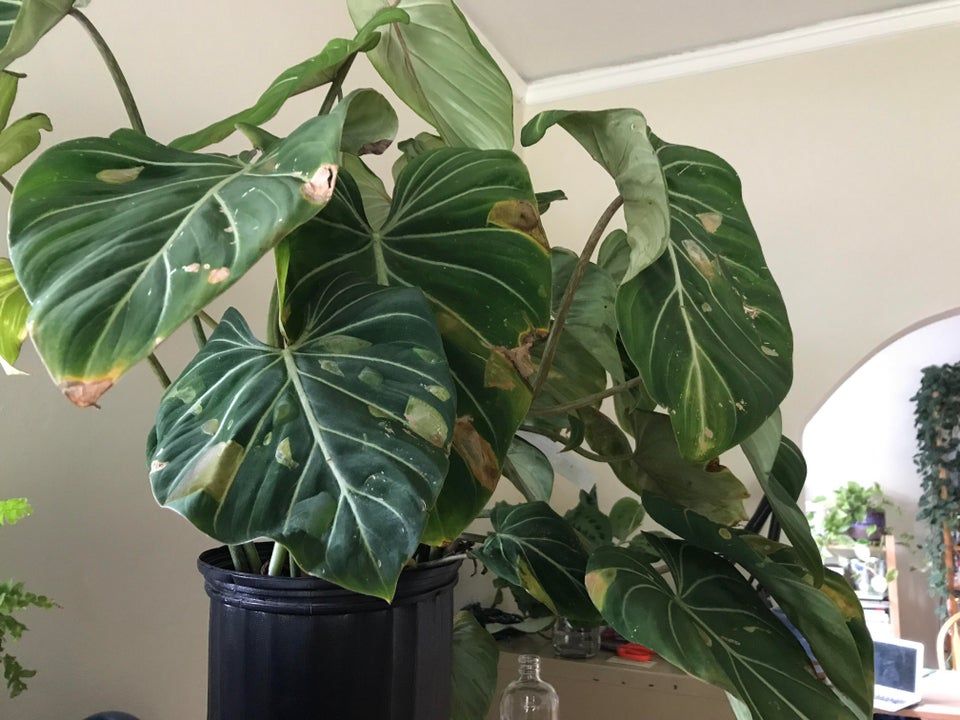
How do you treat Philodendron Gloriosum for pests and diseases?
Natural is best. Neem oil works great for most tropical plant pests. Two teaspoons of neem oil in one litre of water is a potent enough concoction to fight off even the most stubborn spider mite or aphid. You can add in one teaspoon of dish soap if you want an extra kick, but it’s not strictly necessary.
Apply the solution to the leaves and stems via spray bottle every one to two weeks until signs of the pests disappear.
Treating root rot is trickier– There are only really two things you can do. Adjust your watering routine to ensure you are no longer overwatering and hope the roots can recover. Cut away the affected roots, and hope your new routine and good fertilization habits encourage enough growth to stave off plant death.
The most common cause is overwatering, so we suggest assessing and altering your watering habits first.
What Light does Philodendron Gloriosum need?
There’s an ongoing debate in the tropical plant community on whether gloriosum thrives in shaded areas or not. Philodendron Gloriosum is still a reasonably new-ish on the scene houseplant, so the jury is still out. Some owners have had success in well-shaded areas; others have not.
It’s all relative, and our advice is to follow what your plant is telling you. Leggy growth (long stems but poor foliage) and general dropping are sure signs your plant is desperate for more light.
We find it’s best to follow common sense. If you want big, beautiful leaves on your gloriosum, make sure it gets plenty of light like it would in its natural habitat. If you’re not geographically blessed with such access to light, many growers advocate the use of grow lights.
What is the Best Soil for growing Philodendron Gloriosum?
Drainage, drainage, drainage. Get used to hearing it because you’ll need to keep it in mind throughout your gloriosum’s lifetime. Which can be over 15 years if you get your care routine right!
Avoiding root rot is incredibly important. How well the soil you choose to pot your gloriosum in drains plays a crucial role in that endeavour. Most growers will decide to use a good amount of perlite in their potting mix to increase drainage. Adding organic matter into the mix can have similar drainage effects and adds essential nutrients and minerals to help your plant thrive.
Orchid potting soil is a fantastic base soil for Philodendron Gloriosum. It can be mixed with peat moss, perlite and worm castings for a healthy blend that covers all drainage, airflow and nurturing needs. Whatever you do, aim for a pH that is between 6 and 7.5. Aroid mixes are spot on.
Many philodendron enthusiasts advocate using sphagnum peat moss for its light, moisture-retaining properties. This is perfect, as the end goal is to achieve a soil that stays consistently moist but is never soggy.
If you want a mix you can rely on, try the following:
- Two parts peat moss
- One part perlite
- One part worm castings
- Some natural charcoal scattered throughout
Natural charcoal is a not-so-secret ingredient popular throughout the houseplant lover community. Charcoal is a natural toxin eliminator, allows for excellent drainage and airflow, and is super easy to get hold of.
How Do you Propagate Philodendron Gloriosum?
Finally, a tropical houseplant where propagating is simple. Stem cuttings make propagating this beautiful plant to share with others easy. Here’s a quick how-to guide for getting it right every time:
- Use a very sharp knife to cut a section of the rhizome with two leaves on it (but make sure you leave at least three leaves on the mother plant)
- Dip the stem of your cutting in some natural charcoal or cinnamon to disinfect the cut
- Allow the cutting to dry for a little while; a few hours will do
- When dry, place it in a pot with some moist peat moss and cover with a transparent plastic bag.
Simple as that. Make sure to adjust the bag often to encourage airflow and keep up a regular watering routine. Of course, scale it down to accommodate for the cutting’s size.
Propagation is best done in spring or early summer to sync up with gloriosum growing cycles. For an extra growth boost, remember to fertilize your plant.
FAQs about caring for Philodendron Gloriosum
If you stumble upon the gloriosum in its natural Southern and Central American habitat, you might see some delicate white flowers. Flowers are far rarer in the home, and only the luckiest and most dedicated owners will manage to produce any. Provided they have managed to keep their plant alive for 15-16 years!
Why are the leaves yellow on my Philodendron Gloriosum?
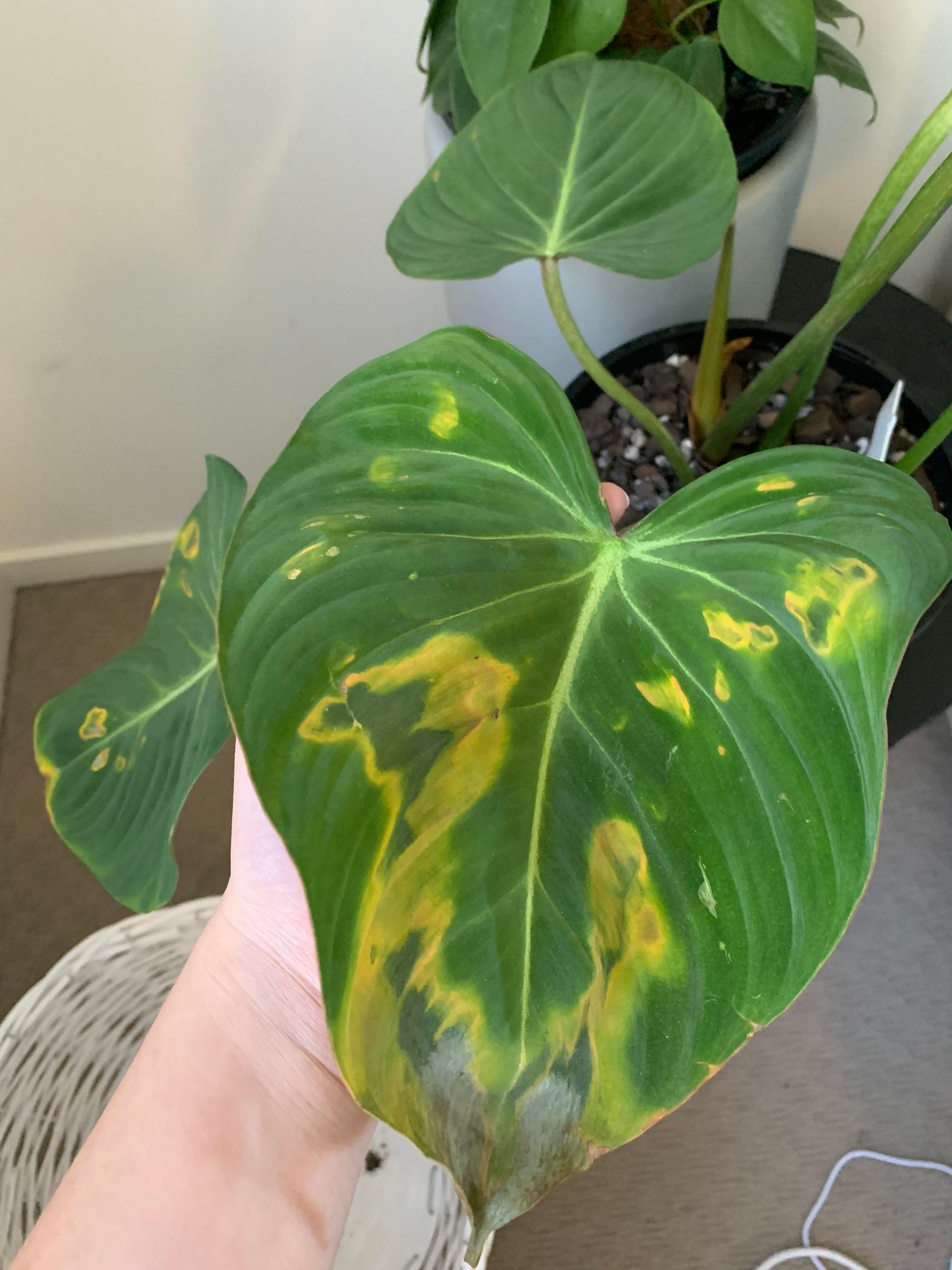
Yellow leaves are a common issue and are usually how your plant tells you something is wrong. The usual culprits are too harsh direct sunlight and overwatering.
Address the issue by first pruning the affected leaves so your plant can concentrate on normal growth. Then, try moving it to an area with less bright direct sun exposure. You can also adjust your soil makeup for something better draining (like adding in perlite or charcoal) or change your watering routine.
Why are the leaves drooping on my Philodendron Gloriosum?

Dropping leaves look sad and usually means your plant feels sad. Causes for this could be over or under-watering. Check the soil of your plant regularly, especially before watering.
If the soil is dry lower than around 2 inches, try watering your plant more often. If it’s still wet or soggy above the 2-inch line, you don’t need to water yet and should adjust your watering routine.
Is Philodendron Gloriosum poisonous?
Very, to humans and animals. Ingesting this plant can lead to swelling in the mouth area, as well as cramps and irritation. If consumed in high quantities, extreme cases can lead to kidney failure, which is very serious.
Keep out of reach of household pets like cats and dogs and well away from children.